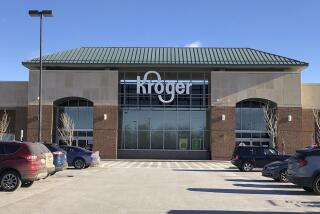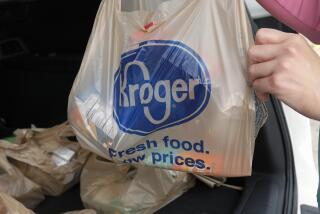Grocery chain Haggen laying off workers as it struggles in Southland
Haggen Inc., the supermarket chain that bet big on California, is laying off employees and cutting worker hours as it struggles to make headway in the highly competitive Southland grocery market.
The Pacific Northwest chain this year bought 146 Albertsons, Vons, Pavilions and Safeway stores, including 83 in California, mostly in the south. It has spent the last few months converting them to the Haggen brand and keeping most of the store employees.
Bill Shaner, Haggen’s executive in charge of California, Nevada and Arizona, has said that Haggen will win over shoppers with higher-quality products at low prices. But this week, the Bellingham, Wash., company acknowledged that Haggen is dealing with “unprecedented” competition in the Southwest.
“To ensure we’re operating as efficiently as possible, we have made the difficult decision to temporarily cut back on staff hours at our stores,” Shaner said.
Haggen, which has about 10,000 employees overall, did not specify how many workers would be affected, nor did it confirm that there have been layoffs. Local employees said some workers have been laid off, including store clerks.
The layoffs and reductions in hours indicate that Haggen is having problems winning shoppers, analysts said.
“Clearly they are underperforming,” said Jim Prevor, a food analyst and founder of PerishablePundit.com. “This is a clear sign that their sales expectations are not being met.”
Haggen is introducing its brand to California at a time when grocers are facing heightened competition for food shoppers. Analysts said Southern California is one of the nation’s most competitive grocery markets, though statistics aren’t publicly available.
Farmers markets are springing up all over the Southland. Smaller chains, including Trader Joe’s, also have been expanding while big-box retailers such as Wal-Mart and Target have been scaling up their food offerings.
Online players Google and Amazon.com also have been pushing grocery delivery. Last month, German discount grocer Aldi said it planned to open 45 Southland stores starting next March.
The supermarkets that Haggen purchased were mostly profitable, but that’s no guarantee of future success, Prevor said.
“The competitive situation has changed,” Prevor said. “That was before Aldi announced they were coming and before Amazon was moving into new areas with their delivery service.”
At one Haggen store in Los Angeles, shoppers had a mixed reaction to the new store that was formerly an Albertsons.
“The prices are higher and I don’t really like it so far,” said Art Webb, 35. “I wouldn’t go out of my way to shop at this store, not even in my neighborhood.”
The Valencia resident, who works as an Uber driver, said he liked shopping at Albertsons for the lower prices. Instead of spending more at Haggen, Webb said he could just go to Whole Foods for a better overall experience.
This store “doesn’t look fancy for the pricing,” he said. “If it’s going to look like a country fair then they should have cheaper prices.”
But Shreyas Mukund, 37, said he liked the customer service and the variety of products.
“I think that the food quality is the same, so are the prices,” the Los Angeles resident said.
Haggen will go through growing pains as it adjusts to running a vastly bigger network of stores in new markets, analysts said.
It was only an 18-store chain in Washington and Oregon when it bought the stores from Albertsons and Safeway, which were forced to sell them as part of a merger to satisfy antitrust concerns raised by the Federal Trade Commission.
The grocer already has hit some bumps. When its first California stores opened in March, about 1,000 items — or about 2.5% of a store’s products — were erroneously overpriced at 10 supermarkets in Los Angeles, Orange and San Diego counties. A smaller number of goods were incorrectly underpriced.
Haggen could take up to a year to adjust its pricing and merchandise selection to meet the needs of its shoppers, said Burt Flickinger III, managing director of Strategic Resource Group. That’s typical for a supermarket that has been taken over by another, he said.
“This is the biggest conversion in Southern California or anywhere else in the last 15 to 20 years,” Flickinger said. “It’s going to be evolutionary to go through the transition and correct the pricing and everything else that comes up.”
But industry watchers said Haggen ultimately will have to make a big decision: Will it keep its brand as a high-quality grocer with great customer service or will it dilute its reputation if that’s what it takes to succeed in California?
Many shoppers who patronized Safeway or Albertsons liked those stores, so changing the concept — even, arguably, for the better — is “a great risk,” Prevor said. Grocery stores typically draw their customer base from within a three-mile radius, so attracting new shoppers also will be difficult.
“It’s like if Saks and Neiman Marcus suddenly bought Sears and turned all those stores into Saks and Neiman Marcus,” he said. “Those stores might not be successful because it doesn’t match the clientele.”
ALSO:
Group sues 13 school districts for not using test scores in teacher evaluations
LAX becomes largest U.S. airport to allow Uber, Lyft pickups
‘Gang mentality’ of middle-age surfers keeps outsiders off Palos Verdes Estates waves
Twitter: @ByShanLi
Twitter: @WhipVillarreal
San Diego Union-Tribune reporter Jonathan Horn contributed to this report.
More to Read
Inside the business of entertainment
The Wide Shot brings you news, analysis and insights on everything from streaming wars to production — and what it all means for the future.
You may occasionally receive promotional content from the Los Angeles Times.











